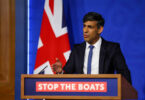Monitoring Desk
Tripoli (AFP) Ten years after Libya’s NATO-backed uprising ousted and killed dictator Moamer Kadhafi, the country remains wracked by conflict and chaos, its population bled dry despite the nation’s vast oil wealth.
A UN-led process has raised cautious hopes that a fragile ceasefire, agreed in October, will bring lasting peace, but for now, Libya is split in two by rival camps with their own militias, mercenaries and foreign backers.
The country’s descent into anarchy has also turned it into North Africa’s main migrant trafficking hub, from where tens of thousands have attempted dangerous boat crossings to Europe.
The horror of their many drownings in the Mediterranean Sea has only been matched by gruesome reports of abuse and torture in militia-run migrant detention camps and the discovery of mass graves of Libyan civilians in the sands of recent battlefields.
“Ten years after the revolution, Libya is even more disfigured a state than it was under Kadhafi,” said Emadeddin Badi, senior analyst at the Geneva-based non-government group Global Initiative.
A decade on, it is clear that the so-called Arab Spring revolts in Libya brought carnage rather than the longed-for freedom and progress, a fate rivalled only by the suffering in war-torn Syria and Yemen.
“The situation is catastrophic for the ordinary citizen because of the repeated conflicts and divisions,” said Mazen Kheirallah, 43, who lives and works in Zaouia, west of the capital Tripoli.
“The coronavirus crisis has made things worse,” said the Libyan Electricity Company employee, who says his family is struggling with runaway inflation and other painful effects of an economy in tatters.
“With prices continuing to rise, we can no longer live with dignity.”
– Decade of war –
Majdi, a 36-year-old dentist, recalls the “spark” for the uprising that began in Benghazi in eastern Libya in February 2011, as a wave of pro-democracy revolts which began in neighbouring Tunisia quickly swept the region.
It was only then “I realised we were living in terror without knowing it”, he said, requesting that his full name not be published.
Libya’s popular uprising — backed by a NATO air campaign led by the United States, Britain and France — ended later that year with the death of Kadhafi, who was hunted down in a drainage tunnel and killed on the spot.
The end of his 42-year dictatorship sparked chaos that destabilised the wider region by flooding it with arms and fighters and, for years, left Libya, a country of seven million, under the control of dozens of trigger-happy militias with shifting allegiances.
Jihadists also took advantage of the security vacuum, with the Islamic State group at its peak orchestrating attacks from a stronghold in the central coastal city of Sirte, killing scores of foreign tourists in Tunisia in 2015 and 2016.
Salima Younis, a 57-year-old divorcee who scrapes by as a part-time secretary at a Tripoli school, says the past decade has been spent “trying to get by day by day, literally dodging bullets”.
A small house she built was badly damaged by fighting three times since 2011 and, without the means to rebuild it again, she eventually sold the land and moved to an apartment.
She said that before 2011, “I worked for over 20 years, earning a decent salary, with foreign oil companies that have all left the country and never came back”.
– Rival power bases –
Libya is now divided between two rival camps based in the key regions of Tripolitania in the west and Cyrenaica in the east, power centres long before the colonial-era creation of the Libyan state.
In the west, the UN-recognised Government of National Accord (GNA) was set up in Tripoli in 2016. It is backed militarily by Turkey, and by the small, gas-rich Gulf nation of Qatar.
The east is controlled by an administration declared by the elected parliament, which does not recognise the GNA, and is backed by military strongman Khalifa Haftar, with the support of the United Arab Emirates, Egypt and Russia.
Haftar’s forces besieged Tripoli for 14 months but were beaten back early last year after Turkey significantly stepped up its support for the GNA.
In just one of the grisly legacies of the war, more than 120 bodies have since been exhumed from mass graves in Tarhuna, southeast of Tripoli, formerly Haftar’s main staging point.
US President Joe Biden’s administration has called for the immediate withdrawal of Russian, Turkish and other foreign forces from Libya, in line with the ceasefire deal.
But some 20,000 mercenaries and foreign fighters remain, in breach of a January 23 deadline to pull out.
Russian military contractors of the Wagner Group backing Haftar’s forces have dug in, quite literally, by bulldozing extensive trenches running south from Sirte, CNN has reported, showing satellite images.
– Progress? –
After years of deadlock, recent months have brought what the UN calls “tangible progress” — a flurry of intra-Libyan talks and a slow rebound in crucial oil production.
Last week, Libyan delegates in Switzerland agreed on a temporary new governing executive.
But huge challenges remain for the process to lead to scheduled national elections on December 24.
While the UN wants Libyans to decide their own future, no settlement appears feasible without the agreement of the foreign powers that have joined the fight by sending soldiers, drones and petro-dollars.
“The situation has stabilised on the surface,” said Badi, speaking before the new executive was announced, cautioning however against excessive optimism in a country that has seen multiple international peace initiatives fail.
The current diplomatic momentum, he said, “is only the by-product of a momentary reticence to continue waging war, rather than a genuine desire to reach a political solution.”
– ‘The people’s suffering’ –
While the Libyan ceasefire has restored a veneer of normalcy, daily life in Tripoli is still marred by frequent power blackouts, fuel shortages and cash restrictions.
Poverty has deepened with the impact of the Covid pandemic, in a country with Africa’s largest proven crude oil reserves but a public health system now largely in ruins.
The energy sector accounts for around 60 percent of economic output and once paid for a generous welfare state.
But the war has caused lengthy shutdowns and left much of the oil infrastructure damaged or dilapidated.
Last year, armed groups loyal to Haftar blocked production and exports from Libya’s most important oil fields and terminals, demanding a “fairer” distribution of revenues, which are managed by the GNA.
Haftar agreed to lift the blockade in September, and by December production had soared to 1.2 million barrels per day — a tenfold increase from before but still far below the at least 1.5 million bpd of the Kadhafi era.
Libya has seen progress but still faces big political challenges, said Global Initiative senior fellow Jalel Harchaoui.
“On a strictly technical level, if you look at the number of Libyans killed on a daily basis, it has dropped a lot,” Harchaoui told AFP.
But, he asked, “has progress been made on a political level? Are we out of the woods? Not at all.
“A lot of things can happen. The population is extremely dissatisfied… The elites are quite indifferent to the people’s suffering.”
Majdi says that despite the country’s difficulties, he does not regret the uprising.
“Even if after 10 years the country is still deep in war, violence and confusion, I don’t regret having supported the revolution. It was necessary and I still believe in it.”
Courtesy: France 24






